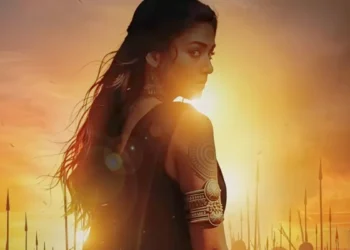Indian animation takes a remarkable step forward with Mahavatar Narsimha, an ambitious film from Hombale Films that reinterprets one of the most compelling narratives in Hindu mythology. This cinematic achievement masterfully combines divine drama with technical prowess, narrating the legendary story of Lord Vishnu’s fierce incarnation as Narsimha—part human, part lion—who rises to vanquish the oppressive demon king, Hiranyakashyap.
Story
Diti, one of sage Kashyapa’s wives, succumbs to desire at an ill-fated moment, disregarding his warning that such an act may yield demonic offspring. Her sons, Hiranyaksha and Hiranyakashipu, grow into fearsome demons trained by Shukracharya to confront Lord Vishnu. After Hiranyaksha is defeated by Vishnu’s Varaha avatar, Hiranyakashipu’s rage intensifies, propelling him to request a boon from Brahma that grants him near-immortality. Ironically, his own son Prahlada becomes a devoted follower of Vishnu, igniting a profound conflict of faith and pride between father and son.
The narrative builds toward the coming of Narasimha, a being beyond description, created to exploit the loopholes of divine law and restore cosmic balance. But how can one conquer an adversary impervious to death by man, beast, day, or night? What kind of justice prevails when the very rules shift? These questions will unfold in the core narrative.
Behind the scenes
The story crafted by Jayapurna Das, Rudra P. Ghosh, and Ashwin Kumar draws from the rich lore of Hindu mythology. Their screenplay is both engaging and thoughtfully constructed. The shlokas that permeate the background, along with the devotional music, resonate deeply with Hindu audiences.
The film successfully depicts the progression from the birth of the two demons to Hiranyakashyapu’s hubris in declaring himself a god, Prahlada’s budding devotion to Lord Vishnu, Hiranyakashyapu’s attempts to eliminate his son, and ultimately, Vishnu’s transformation into Narasimha. This sequence of events is thrillingly presented, with the climactic battle between Narasimha and Hiranyakashyapu particularly exhilarating, prompting applause and cheers for Narasimha.
On a technical level, the film exceeds expectations, boasting solid production values and wise budgeting. The fantasy realm is richly detailed and nuanced, steering clear of the flatness commonly found in lower-budget animations. Hombale Films is commendable for backing such a daring and genre-bending project.
The Telugu dubbing is executed seamlessly, with well-selected voice actors and careful synchronization that create an authentic viewing experience. It stands out as a rare instance where a dubbed film feels like an original production.
Sam C.S.’s score is a significant asset, enhancing both the grand scale and emotional depth of the narrative. His musical cues harmonize beautifully with the mythological essence of the film, amplifying its dramatic moments.
Director Ashwin Kumar, who also managed the editing, merits special praise for his vision and meticulous control over the project, although the pacing could benefit from finer adjustments.
Final Verdict
Overall, Mahavatar Narsimha is a notable and praiseworthy addition to Indian cinema—a devotional animated feature that weaves together mythology, emotion, and visual spectacle. The sequences involving Varaha and Narasimha stand out with their visual vibrancy and spiritual significance.
While the film does face some pacing issues and certain narrative gaps, it compensates for these shortcomings with its sincerity, ambition, and artistic richness. For those intrigued by mythological narratives or interested in exploring India’s evolving animation industry, this is an experience best enjoyed in theaters, especially in 3D to fully appreciate its visual splendor.
In a time when younger generations gravitate toward Western culture—with many star-studded films getting bombed at boxoffice, it is refreshing to see director Ashwin Kumar striving to re-engage them with Indian culture in a captivating manner. This larger-than-life action spectacle inspires pride in cultural heritage and is certainly worth watching only in theaters.






















